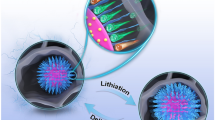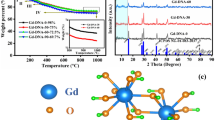Abstract
Finite saturated regular carbon nanotubes (CNTs) are predicted to exhibit higher capacity as hydrogen storage media compared to unsaturated regular CNTs. In the present study, molecular hydrogen physisorption energies (MHPEs) for finite saturated and unsaturated bumpy defected CNTs were calculated by density functional theory (DFT-D3) methods at the B3LYP/6-31G(d) theory level, with rigorous inclusion of van der Waals interactions. The calculated MHPEs for both regular and bumpy defected armchair, chiral and zigzag CNTs with similar diameters and lengths, with and without nitrogen doping, were compared in terms of Eph/H2, defined as the MHPE per hydrogen molecule adsorbed inside the nanotube. For all studied systems, Eph/H2 increased with the number of physisorbed hydrogen molecules. Nitrogen doping of regular and bumpy CNTs resulted in an increase in the Eph/H2 values, with the exception of bumpy chiral nanotubes. The results of this study demonstrate that bumpy defects are important nanotube structural features whose effects depend on nanotube chirality. For instance, bumpy defects were beneficial for undoped and doped zigzag nanotubes, resulting in a decrease in Eph/H2 values for regular structures from 0.5 and 0.74 to 0.26 and 0.42 eV, respectively. By contrast, for doped armchair regular structures with an Eph/H2 value of 0.38 eV, bumpy defects increased Eph/H2 to 0.45 eV. These Eph/H2 values for bumpy doped armchair and the zigzag nanotubes are all within the range of 0.1–0.5 eV/H2 reported as ideal for reversible hydrogen storage under environmental conditions.










Similar content being viewed by others
References
Kim EK, Kim T, Paik S, Haam S, Huh YM, Lee K (2015) Chem Rev 115:327–394
Yoosefian M, Barzgari Z, Yoosefian J (2014) Struct Chem 25(1):9
Abdelhalim A, Abdellah A, Scarpa G, Lugli P (2014) Nanotechnology 25(5):5208. doi:10.1088/0957-4484/25/5/055208
Bareket-Keren L, Hanein Y (2013) Front Neural Circuits 6:112. doi:10.3389/fncir.2012.00122
De Volder MFL, Tawfick SH, Baughman RH, Hart AJ (2013) Science 339:535
Bianco S (2011) Carbon nanotubes. From research to applications. InTech, Rijeka
Marulanda JM (2010) Carbon nanotubes. InTech, Rijeka
Arsawang U, Saengsawang O, Rungrotmongkol T, Sornmee P, Wittayanarakul K, Remsungnen T, Hannongbua S (2011) J Mol Graph Model 29:591–596
Meng L, Zhang X, Lu Q, Fei Z, Dyson PJ (2012) Biomaterials 33:1689–1698
Tada K, Furuya S, Watanabe K (2001) Phys Rev B 63:155405
Krishna R, Titus E, Salimian M, Okhay O, Rajendran S, Rajkumar A, Sousa JMG, Ferreira ALC, Campos-Gil J, Gracio J (2012) In: J Liu (ed) Hydrogen storage, chap 10. doi:10.5772/51238. ISBN 978-953-51-0731-6
Li J, Furuta T, Goto H, Ohashi T, Fujiwara Y, Yip S (2003) J Chem Phys 119:2376
Bhatia SK, Myers AL (2006) Langmuir 22:1688–1700
Dillon AC, Jones KM, Bekkedahl TA, Kiang CH, Bethune DS, Heben MJ (1997) Nature 386(6623):377–379
Becher M, Haluska M, Hirscher M, Quintel A, Skakalova V, Dettlaff-Weglikovska U, Chen X, Hulman M, Choi Y, Roth S, Meregalli V, Parrinello M, Ströbel R, Jörissen L, Kappes MM, Fink J, Züttel A, Stepanek I, Bernier P (2003) C R Phys 4:1055–1062
Züttel A (2003) Mater Today 6:24
Alonso JA, Arellano JS, Molina LM, Rubio A, López MJ (2004) IEEE Trans Nanotechnol 3:304–310
Ross DK (2006) Vacuum 80:1084–1089
Zhang G, Qi P, Wang X, Lu Y, Mann D, Li X, Dai H (2006) J Am Chem Soc 128:6026–6027
Bilic A, Gale JD (2008) J Phys Chem C 112:12568–12575
Dinadayalane TC, Kaczmarek A, Lukaszewicz J, Leszczynski J (2007) J Phys Chem C 111:7376–7383
Kaczmarek A, Dinadayalane TC, Lukaszewicz J, Leszczynski J (2007) Int J Quantum Chem 107:2211–2219
Baughman RH, Zakhidov AA, de Heer WA (2002) Science 297(5582):787–792
Orimo S, Züttel A, Schlapbach L, Majer G, Fukunaga T, Fujii H (2003) J Alloys Compd 356–357:716–719
Han SS, Lee HM (2004) Carbon 42(11):2169–2177
DOE targets for onboard hydrogen storage systems for light-duty vehicles. http://energy.gov/sites/prod/files/2015/01/f19/fcto_myrdd_table_onboard_h2_storage_systems_doe_targets_ldv.pdf. Accessed 27 Jan 2016; http://www.eere.energy.gov/hydrogenandfuelcells/storage/pdfs/targets_onboard_hydro_storage_explanation.pdf. Accessed 27 Jan 2016; http://www1.eere.energy.gov/hydrogenandfuelcells/storage/current_technology.html. Accessed 27 Jan 2016
Charlier JC (2002) Acc Chem Res 35:1063–1069
Contreras ML, Avila D, Alvarez J, Rozas R (2012) J Mol Graphs Model 38:389
Contreras ML, Rozas R (2011) In: Bianco S (ed) Carbon nanotubes. From research to applications. Intech, Rijeka. http://www.intech.open.com/books/carbon-nanotubes-from-research-to-applications/nitrogen-containing-carbon-nanotubes-a-theoretical-approach
Contreras ML, Cortés-Arriagada D, Villarroel I, Alvarez J, Rozas R (2014) Struct Chem 25:1045–1056
Singh AK, Yakobson BI (2012) J Mater Sci 47:7356–7366
Hamada N, Sawada S, Oshiyama A (1992) Phys Rev Lett 68(10):1579–1581
HyperChem release 7.5. Hypercube Inc., Gainesville
Jaguar version 8.1. Schrödinger LLC, New York, 2013
Grimme S, Antony J, Ehrlich S, Krieg H (2010) J Chem Phys 132(15):154104
Hujo W, Grimme S (2011) J Chem Theory Comput 7(12):3866–3871
DiLabio GA, Koleini M, Torres E (2013) Theor Chem Acc 132:1389
Dinadayalane TC, Leszczynski J (2010) Struct Chem 21:1155
Contreras ML, Villarroel I, Rozas R (2015) Struct Chem 26(3):761–771. doi:10.1007/s11224-014-0535-y
Zhao M, Xia Y, Lewis JP, Zhang RJ (2003) Appl Phys 94:2398
Ho YW, Suen MC (2013) J Chem 2013:765243. doi:10.1155/2013/765243
Amaral SS, Campos PT, dos Santos JM, Fernandes LS, Martins MAP, Bonacorso HG, Zanatta N (2010) Open Crystallogr J 3:59–66
Yao Y (2010) In: Marulanda JM (ed) Carbon nanotubes. InTech, Rijeka
Lochan RC, Head-Gordon M (2006) Phys Chem Chem Phys 8:1357–1370
Acknowledgments
This work was partially supported by the Direction of Scientific and Technological Research DICYT-USACH Project no. 061642CF and by the Sociedad de Desarrollo Tecnológico SDT-USACH Project no. CIA 2981. In addition, the central cluster of the Faculty of Chemistry and Biology and the VRIDeI of the University of Santiago de Chile are acknowledged for allocating computational resources.
Author information
Authors and Affiliations
Corresponding author
Ethics declarations
Conflict of interest
The authors declare that they have no conflict of interest.
Rights and permissions
About this article
Cite this article
Contreras, M.L., Villarroel, I. & Rozas, R. Hydrogen physisorption energies for bumpy, saturated, nitrogen-doped single-walled carbon nanotubes. Struct Chem 27, 1479–1490 (2016). https://doi.org/10.1007/s11224-016-0767-0
Received:
Accepted:
Published:
Issue Date:
DOI: https://doi.org/10.1007/s11224-016-0767-0




